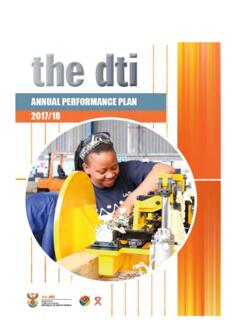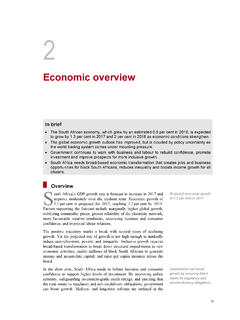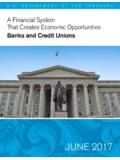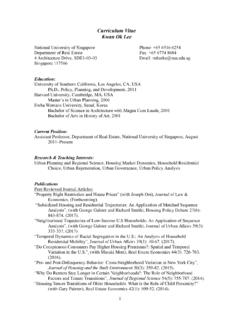Transcription of Transformation for inclusive growth - National …
1 11 Transformation for inclusive growth To realise the vision of the Constitution, South Africa needs Transformation that opens a path to inclusive economic growth and development. growth without Transformation would only reinforce the inequitable patterns of wealth inherited from the past. Transformation without economic growth would be narrow and unsustainable. Government s objective is not merely to transfer ownership of assets or opportunities to contract with the state: it is to change the structure of the economy. Broad-based Transformation should promote growth , mobilise investment, create jobs and empower citizens.
2 It must create new resources to support social change, including assets and livelihoods for the majority, and strengthen South Africa s constitutional foundations. The budget plays a central role in Transformation by promoting redistribution and directing scarce resources towards catalytic investments in human and physical capital. But the budget depends on the economy to generate the resources to finance these investments, and South Africa has had several years of very low growth . The 2017 Budget proposes several difficult trade-offs to safeguard citizens quality of life, improve the efficiency of spending and ensure that the public finances are sustainable.
3 Introduction outh Africa faces difficult choices in a rapidly changing world. Economic growth , which has steadily weakened over the past five years, is likely to increase moderately over the medium term. Yet this rate of growth will not be sufficient to markedly reduce unemployment, poverty and inequality. Government s measured fiscal consolidation is working to narrow the budget deficit and stabilise debt, building confidence in the economy. But substantial revenue under-collection in 2016/17 has imposed sharper limits on public spending. At the same time, the rise of aggressive unilateralism in advanced economies, and mounting uncertainty over the course of world trade, pose serious threats to the global outlook.
4 In the context of these pressures, the 2017 Budget sets out a series of proposals to raise additional revenue, sustain core expenditure, improve SGrowth outlook has improved, but revenue under-collection imposes sharp fiscal limits 2017 BUDGET REVIEW 2value for money spent, stabilise the public finances, and contribute to growth and Transformation . Rising global uncertainty Between 2000 and 2008, South Africa s economic fortunes rose on the strength of a commodity boom and robust domestic investment. The economy expanded rapidly and created jobs. Government developed an ambitious policy agenda, eventually articulated in the National Development Plan (NDP).
5 When the global financial crisis broke in 2008, the healthy state of the public finances enabled government to intervene decisively to support the economy, while sustaining social programmes and continuing to invest in infrastructure. But by 2011, the year that the NDP was published, the decade-long upswing in commodity prices had begun to turn, signalling deeper shifts in the global economy. The pace of Chinese industrialisation began to flag. World trade began to slow. A debt crisis broke out in Europe. Geopolitical tensions began to rise. Longer-term trends in developed countries ageing populations, slowing productivity and widening inequality became more pronounced.
6 Imbalances in globalisation, stagnant incomes for the majority and distrust of elites took centre stage in global discourse. Figure South African commodity export price index1 1 Average of real US$ price indices of South Africa s largest commodity exports weighted with average export share over the last 10 years Source: Jacks, DS. (2013). From Boom to Bust: A Typology of Real Commodity Prices in the Long Run. National Bureau of Economic Research and Quantec trade data Over the past year, these developments culminated in a series of political shifts in the US and Europe. They find expression in strident economic nationalism, disdain for multilateral institutions and demands to tighten National borders.
7 The policy direction of the new US administration, the outcome of the UK s vote to leave the European Union, and upcoming elections in France and Germany are contributing to global uncertainty, given that these developments directly involve four of the world s largest economies. South Africa s ambitious agenda articulated in NDP Imbalances in globalisation and stagnating incomes have moved to centre of global discourse Events in US and UK, and upcoming polls in France and Germany, contribute to global uncertainty CHAPTER 1: Transformation FOR inclusive growth 3 growth on the African continent has also fallen sharply. Despite sustained improvements in governance and economic management in many countries, a continued dependence on commodity exports makes African economies vulnerable to sudden reversals of fortune.
8 South Africa is a small, open economy reliant on trade and capital flows. Its development rests on a fair, rules-based global trading and financial system. The implications of recent international developments for South Africa s economic trajectory need to be carefully considered. Over the medium term, pressure on the world economy is expected to increase. The resulting uncertainty is the single biggest risk to global economic recovery, with potentially serious consequences for South Africa. An opportunity for change South Africa can use this turning point in the world economy as an opportunity to strengthen economic and social Transformation .
9 The country has multiple strengths on which to build. Government s macroeconomic policies, which include inflation targeting and a flexible exchange rate, promote a stable platform for investment and provide a buffer against global volatility. Deep and liquid financial markets support both public- and private-sector borrowing. The country s institutions from the courts to the Reserve Bank retain their independence and integrity. Over the medium term, economic growth is forecast to improve moderately on the strength of several developments: The real exchange rate has depreciated, boosting competitiveness An uptick in commodity prices is expected to carry through into 2017 The severe drought has eased in several farming regions Electricity supply has stabilised Improved labour relations are expected to boost job creation.
10 Despite the improving outlook, South Africa needs far higher rates of economic growth to reduce mass unemployment, poverty and inequality. In 2016, domestic investment contracted for the first time since 2010. Investment by private businesses declined by per cent. In the short term, the low level of private-sector investment is the main factor limiting economic growth . Reversing this pattern requires concentrated efforts to strengthen business and consumer confidence. Table Macroeconomic outlook summary2016201720182019 Real percentage growthEstimateForecastHousehold Gross fixed-capital formation Exports Imports Real GDP Consumer price inflation (CPI) Current account balance (% of GDP).
















